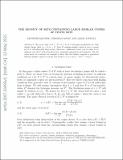Files in this item
The density of sets containing large similar copies of finite sets
Item metadata
| dc.contributor.author | Falconer, Kenneth | |
| dc.contributor.author | Kovač, Vjekoslav | |
| dc.contributor.author | Yavicoli, Alexia | |
| dc.date.accessioned | 2021-10-19T14:30:01Z | |
| dc.date.available | 2021-10-19T14:30:01Z | |
| dc.date.issued | 2022-11-17 | |
| dc.identifier | 269135153 | |
| dc.identifier | cb498bc5-7ca8-42c1-84c0-db7499aedc15 | |
| dc.identifier | 85142193997 | |
| dc.identifier | 000884960700003 | |
| dc.identifier.citation | Falconer , K , Kovač , V & Yavicoli , A 2022 , ' The density of sets containing large similar copies of finite sets ' , Journal d'Analyse Mathématique , vol. 148 , no. 1 , pp. 339-359 . https://doi.org/10.1007/s11854-022-0231-6 | en |
| dc.identifier.issn | 0021-7670 | |
| dc.identifier.other | ArXiv: http://arxiv.org/abs/2007.03493v1 | |
| dc.identifier.other | ORCID: /0000-0001-8823-0406/work/123196745 | |
| dc.identifier.uri | https://hdl.handle.net/10023/24167 | |
| dc.description | Funding: VK is supported by the Croatian Science Foundation, project n◦ UIP-2017-05-4129 (MUNHANAP). AY is supported by the Swiss National Science Foundation, grant n◦ P2SKP2 184047. | en |
| dc.description.abstract | We prove that if E⊆Rd (d≥2) is a Lebesgue-measurable set with density larger than (n−2) (n−1), then E contains similar copies of every n-point set P at all sufficiently large scales. Moreover, 'sufficiently large' can be taken to be uniform over all P with prescribed size, minimum separation and diameter. On the other hand, we construct an example to show that the density required to guarantee all large similar copies of n-point sets tends to 1 at a rate 1−O(n−1/5log n). | |
| dc.format.extent | 21 | |
| dc.format.extent | 256093 | |
| dc.format.extent | 266131 | |
| dc.language.iso | eng | |
| dc.relation.ispartof | Journal d'Analyse Mathématique | en |
| dc.subject | Pattern | en |
| dc.subject | Density | en |
| dc.subject | Similarity | en |
| dc.subject | Arithmetic progression | en |
| dc.subject | Discrepancy | en |
| dc.subject | QA Mathematics | en |
| dc.subject | T-NDAS | en |
| dc.subject | MCC | en |
| dc.subject.lcc | QA | en |
| dc.title | The density of sets containing large similar copies of finite sets | en |
| dc.type | Journal article | en |
| dc.contributor.institution | University of St Andrews. Pure Mathematics | en |
| dc.identifier.doi | 10.1007/s11854-022-0231-6 | |
| dc.description.status | Peer reviewed | en |
| dc.date.embargoedUntil | 2023-11-17 | |
| dc.identifier.url | https://arxiv.org/abs/2007.03493 | en |
This item appears in the following Collection(s)
Items in the St Andrews Research Repository are protected by copyright, with all rights reserved, unless otherwise indicated.


